Childhood Accidents Prevention and Safety Measures
VerifiedAdded on 2021/04/16
|15
|3185
|27
AI Summary
This assignment provides an in-depth analysis of childhood accidents, including their common causes, risk factors, and prevention strategies. It discusses the importance of home safety, accident surveillance systems, and socioeconomic variations in injury severity. The assignment also references various studies and reports on child mortality, accident statistics, and safety measures to improve home safety in Europe.
Contribute Materials
Your contribution can guide someone’s learning journey. Share your
documents today.
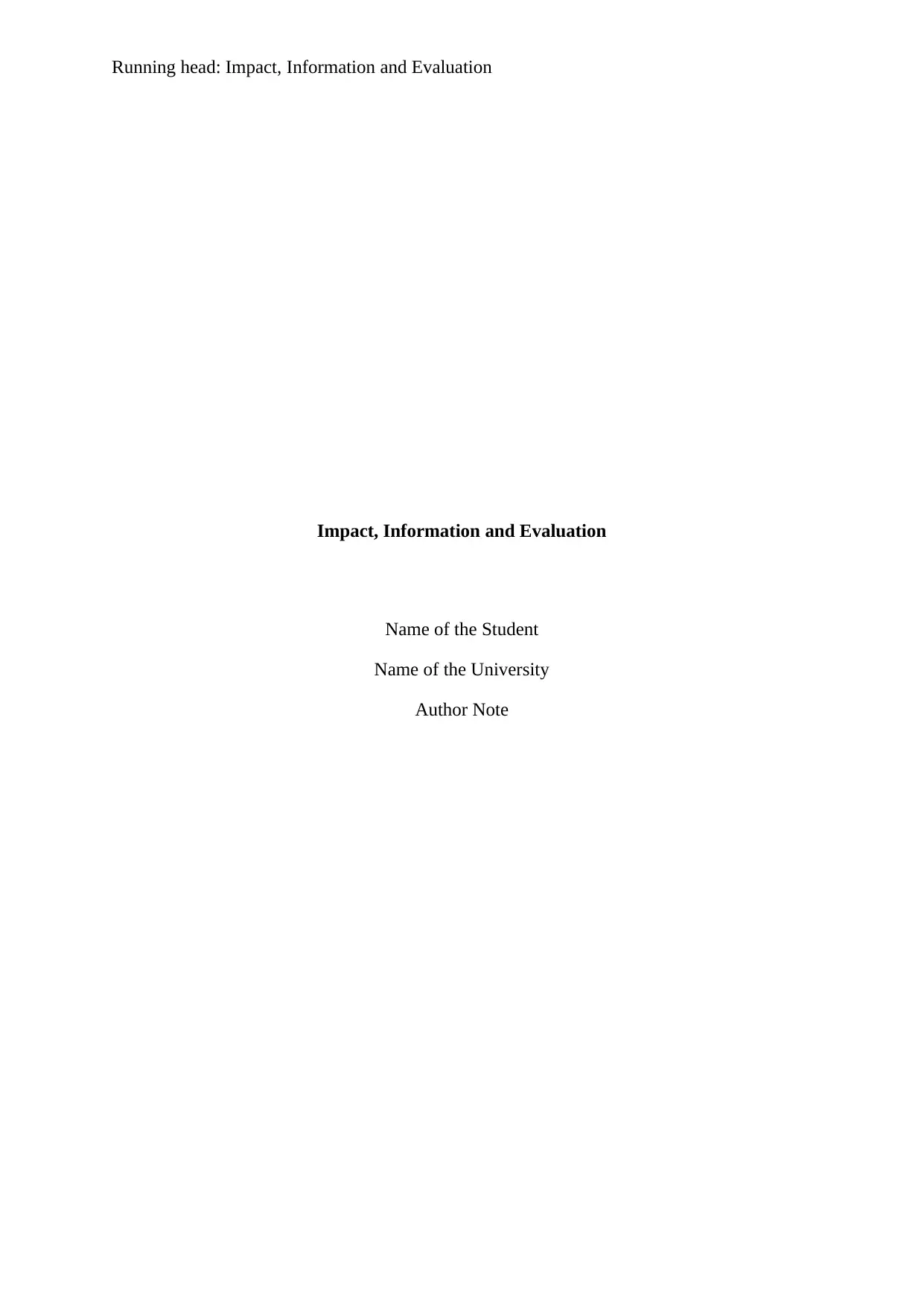
Running head: Impact, Information and Evaluation
Impact, Information and Evaluation
Name of the Student
Name of the University
Author Note
Impact, Information and Evaluation
Name of the Student
Name of the University
Author Note
Secure Best Marks with AI Grader
Need help grading? Try our AI Grader for instant feedback on your assignments.
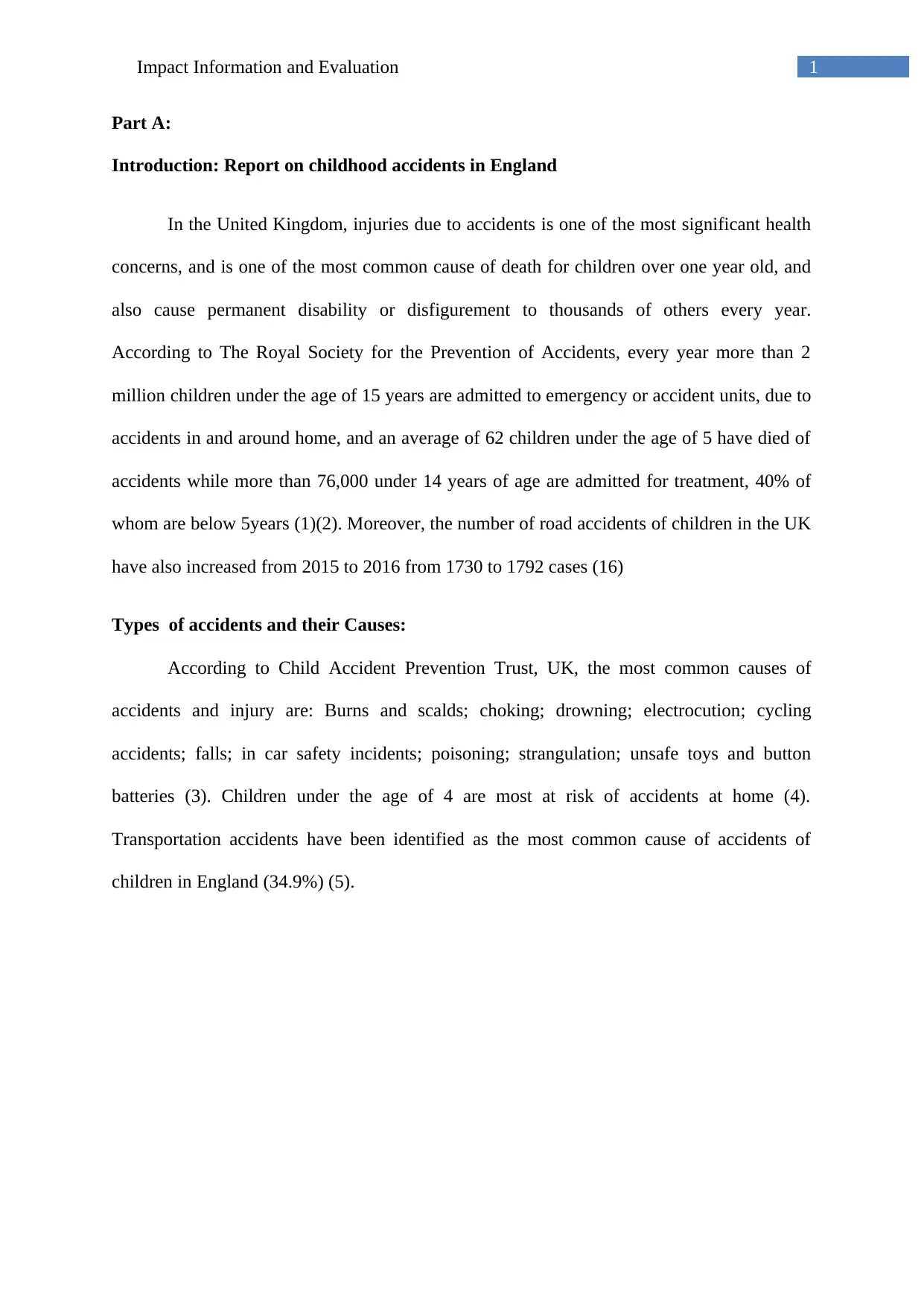
1Impact Information and Evaluation
Part A:
Introduction: Report on childhood accidents in England
In the United Kingdom, injuries due to accidents is one of the most significant health
concerns, and is one of the most common cause of death for children over one year old, and
also cause permanent disability or disfigurement to thousands of others every year.
According to The Royal Society for the Prevention of Accidents, every year more than 2
million children under the age of 15 years are admitted to emergency or accident units, due to
accidents in and around home, and an average of 62 children under the age of 5 have died of
accidents while more than 76,000 under 14 years of age are admitted for treatment, 40% of
whom are below 5years (1)(2). Moreover, the number of road accidents of children in the UK
have also increased from 2015 to 2016 from 1730 to 1792 cases (16)
Types of accidents and their Causes:
According to Child Accident Prevention Trust, UK, the most common causes of
accidents and injury are: Burns and scalds; choking; drowning; electrocution; cycling
accidents; falls; in car safety incidents; poisoning; strangulation; unsafe toys and button
batteries (3). Children under the age of 4 are most at risk of accidents at home (4).
Transportation accidents have been identified as the most common cause of accidents of
children in England (34.9%) (5).
Part A:
Introduction: Report on childhood accidents in England
In the United Kingdom, injuries due to accidents is one of the most significant health
concerns, and is one of the most common cause of death for children over one year old, and
also cause permanent disability or disfigurement to thousands of others every year.
According to The Royal Society for the Prevention of Accidents, every year more than 2
million children under the age of 15 years are admitted to emergency or accident units, due to
accidents in and around home, and an average of 62 children under the age of 5 have died of
accidents while more than 76,000 under 14 years of age are admitted for treatment, 40% of
whom are below 5years (1)(2). Moreover, the number of road accidents of children in the UK
have also increased from 2015 to 2016 from 1730 to 1792 cases (16)
Types of accidents and their Causes:
According to Child Accident Prevention Trust, UK, the most common causes of
accidents and injury are: Burns and scalds; choking; drowning; electrocution; cycling
accidents; falls; in car safety incidents; poisoning; strangulation; unsafe toys and button
batteries (3). Children under the age of 4 are most at risk of accidents at home (4).
Transportation accidents have been identified as the most common cause of accidents of
children in England (34.9%) (5).
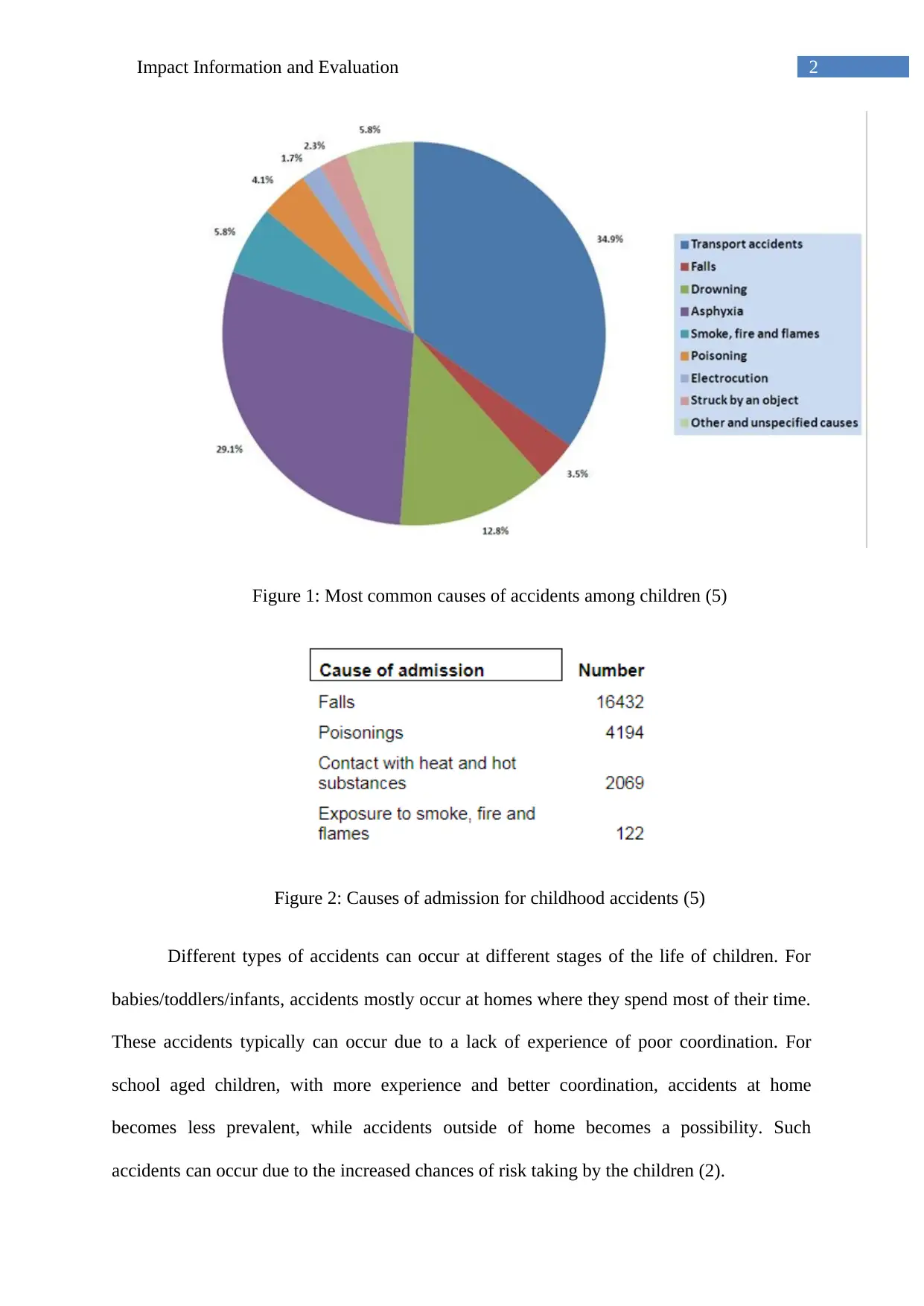
2Impact Information and Evaluation
Figure 1: Most common causes of accidents among children (5)
Figure 2: Causes of admission for childhood accidents (5)
Different types of accidents can occur at different stages of the life of children. For
babies/toddlers/infants, accidents mostly occur at homes where they spend most of their time.
These accidents typically can occur due to a lack of experience of poor coordination. For
school aged children, with more experience and better coordination, accidents at home
becomes less prevalent, while accidents outside of home becomes a possibility. Such
accidents can occur due to the increased chances of risk taking by the children (2).
Figure 1: Most common causes of accidents among children (5)
Figure 2: Causes of admission for childhood accidents (5)
Different types of accidents can occur at different stages of the life of children. For
babies/toddlers/infants, accidents mostly occur at homes where they spend most of their time.
These accidents typically can occur due to a lack of experience of poor coordination. For
school aged children, with more experience and better coordination, accidents at home
becomes less prevalent, while accidents outside of home becomes a possibility. Such
accidents can occur due to the increased chances of risk taking by the children (2).
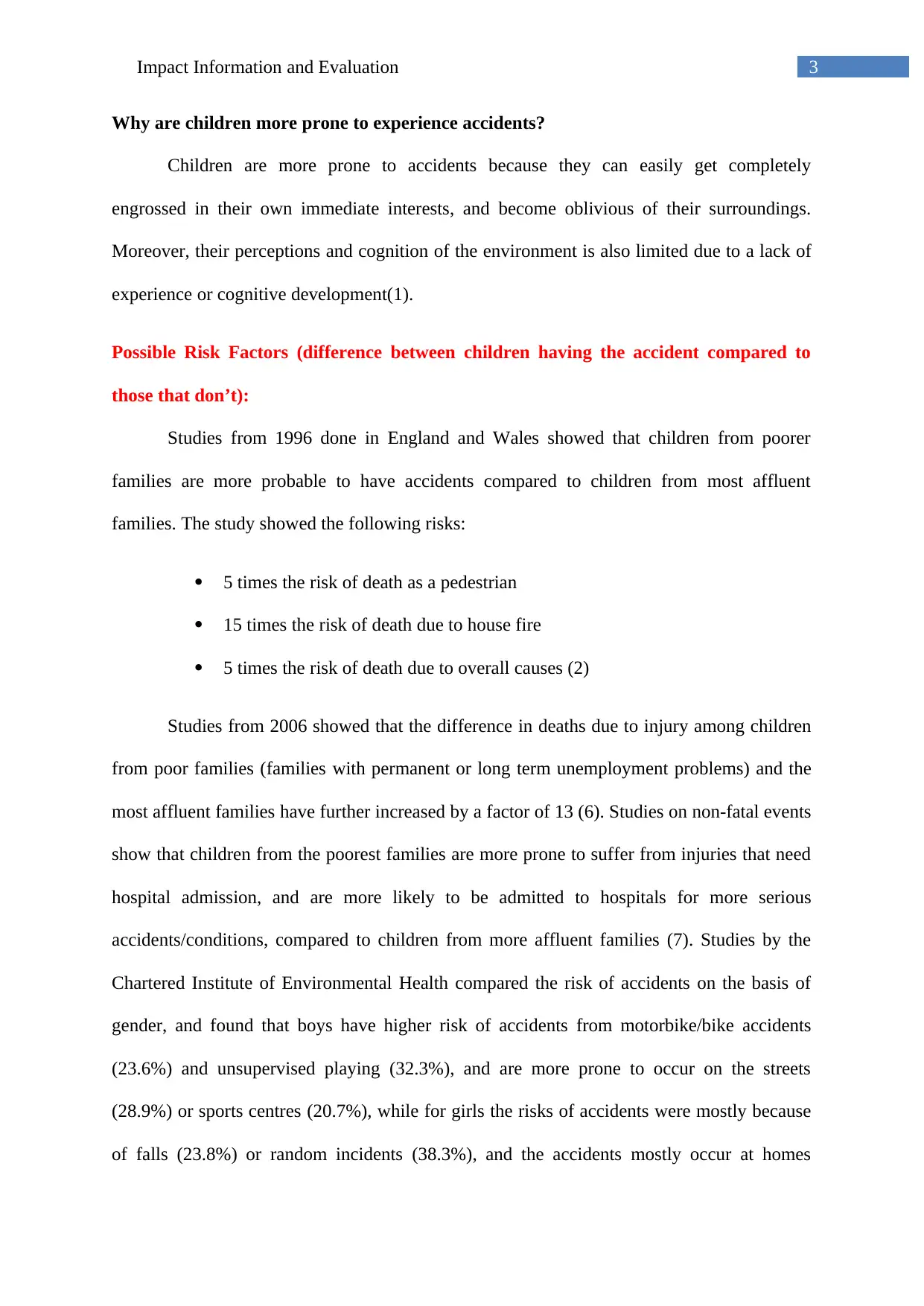
3Impact Information and Evaluation
Why are children more prone to experience accidents?
Children are more prone to accidents because they can easily get completely
engrossed in their own immediate interests, and become oblivious of their surroundings.
Moreover, their perceptions and cognition of the environment is also limited due to a lack of
experience or cognitive development(1).
Possible Risk Factors (difference between children having the accident compared to
those that don’t):
Studies from 1996 done in England and Wales showed that children from poorer
families are more probable to have accidents compared to children from most affluent
families. The study showed the following risks:
5 times the risk of death as a pedestrian
15 times the risk of death due to house fire
5 times the risk of death due to overall causes (2)
Studies from 2006 showed that the difference in deaths due to injury among children
from poor families (families with permanent or long term unemployment problems) and the
most affluent families have further increased by a factor of 13 (6). Studies on non-fatal events
show that children from the poorest families are more prone to suffer from injuries that need
hospital admission, and are more likely to be admitted to hospitals for more serious
accidents/conditions, compared to children from more affluent families (7). Studies by the
Chartered Institute of Environmental Health compared the risk of accidents on the basis of
gender, and found that boys have higher risk of accidents from motorbike/bike accidents
(23.6%) and unsupervised playing (32.3%), and are more prone to occur on the streets
(28.9%) or sports centres (20.7%), while for girls the risks of accidents were mostly because
of falls (23.8%) or random incidents (38.3%), and the accidents mostly occur at homes
Why are children more prone to experience accidents?
Children are more prone to accidents because they can easily get completely
engrossed in their own immediate interests, and become oblivious of their surroundings.
Moreover, their perceptions and cognition of the environment is also limited due to a lack of
experience or cognitive development(1).
Possible Risk Factors (difference between children having the accident compared to
those that don’t):
Studies from 1996 done in England and Wales showed that children from poorer
families are more probable to have accidents compared to children from most affluent
families. The study showed the following risks:
5 times the risk of death as a pedestrian
15 times the risk of death due to house fire
5 times the risk of death due to overall causes (2)
Studies from 2006 showed that the difference in deaths due to injury among children
from poor families (families with permanent or long term unemployment problems) and the
most affluent families have further increased by a factor of 13 (6). Studies on non-fatal events
show that children from the poorest families are more prone to suffer from injuries that need
hospital admission, and are more likely to be admitted to hospitals for more serious
accidents/conditions, compared to children from more affluent families (7). Studies by the
Chartered Institute of Environmental Health compared the risk of accidents on the basis of
gender, and found that boys have higher risk of accidents from motorbike/bike accidents
(23.6%) and unsupervised playing (32.3%), and are more prone to occur on the streets
(28.9%) or sports centres (20.7%), while for girls the risks of accidents were mostly because
of falls (23.8%) or random incidents (38.3%), and the accidents mostly occur at homes
Secure Best Marks with AI Grader
Need help grading? Try our AI Grader for instant feedback on your assignments.
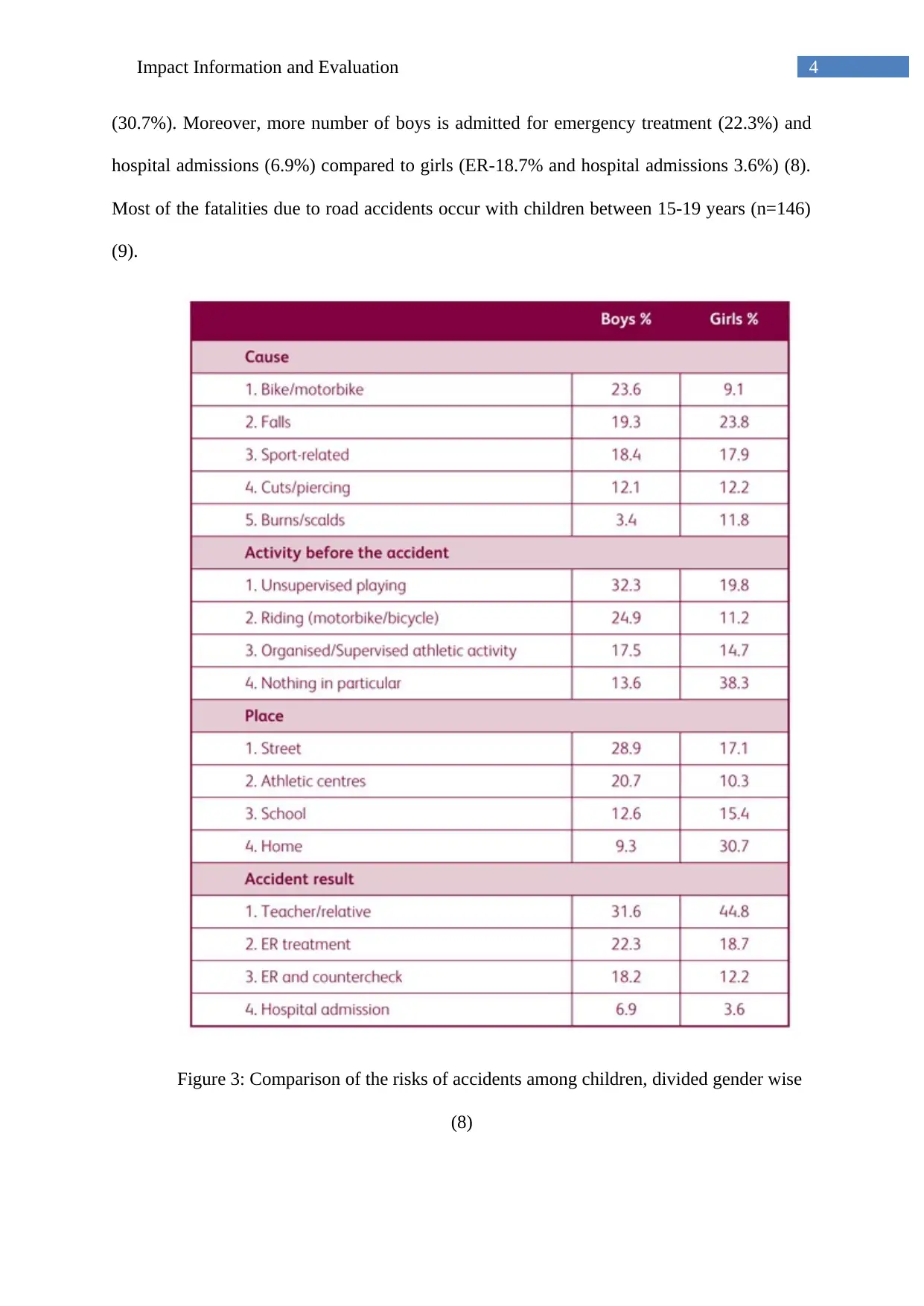
4Impact Information and Evaluation
(30.7%). Moreover, more number of boys is admitted for emergency treatment (22.3%) and
hospital admissions (6.9%) compared to girls (ER-18.7% and hospital admissions 3.6%) (8).
Most of the fatalities due to road accidents occur with children between 15-19 years (n=146)
(9).
Figure 3: Comparison of the risks of accidents among children, divided gender wise
(8)
(30.7%). Moreover, more number of boys is admitted for emergency treatment (22.3%) and
hospital admissions (6.9%) compared to girls (ER-18.7% and hospital admissions 3.6%) (8).
Most of the fatalities due to road accidents occur with children between 15-19 years (n=146)
(9).
Figure 3: Comparison of the risks of accidents among children, divided gender wise
(8)
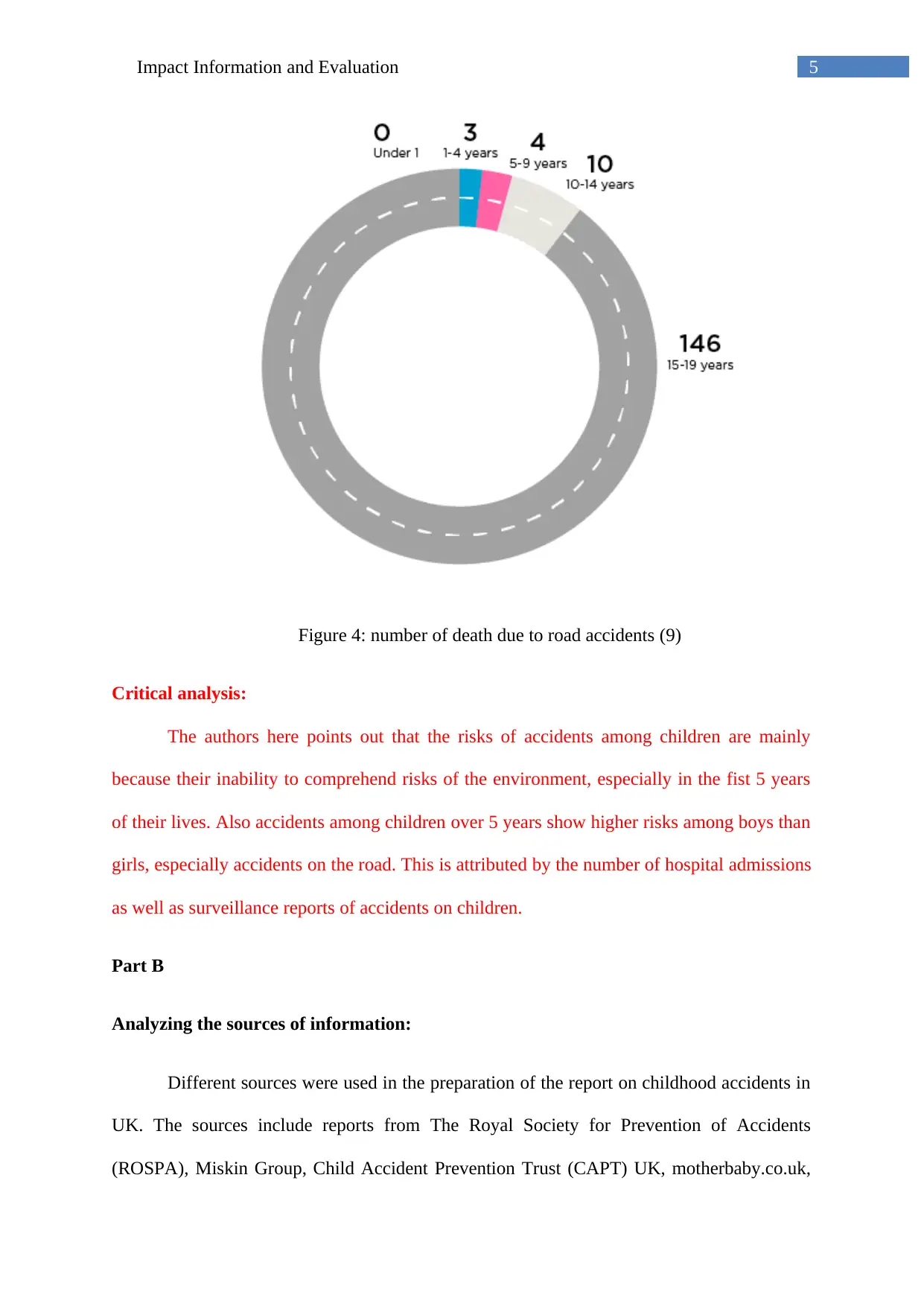
5Impact Information and Evaluation
Figure 4: number of death due to road accidents (9)
Critical analysis:
The authors here points out that the risks of accidents among children are mainly
because their inability to comprehend risks of the environment, especially in the fist 5 years
of their lives. Also accidents among children over 5 years show higher risks among boys than
girls, especially accidents on the road. This is attributed by the number of hospital admissions
as well as surveillance reports of accidents on children.
Part B
Analyzing the sources of information:
Different sources were used in the preparation of the report on childhood accidents in
UK. The sources include reports from The Royal Society for Prevention of Accidents
(ROSPA), Miskin Group, Child Accident Prevention Trust (CAPT) UK, motherbaby.co.uk,
Figure 4: number of death due to road accidents (9)
Critical analysis:
The authors here points out that the risks of accidents among children are mainly
because their inability to comprehend risks of the environment, especially in the fist 5 years
of their lives. Also accidents among children over 5 years show higher risks among boys than
girls, especially accidents on the road. This is attributed by the number of hospital admissions
as well as surveillance reports of accidents on children.
Part B
Analyzing the sources of information:
Different sources were used in the preparation of the report on childhood accidents in
UK. The sources include reports from The Royal Society for Prevention of Accidents
(ROSPA), Miskin Group, Child Accident Prevention Trust (CAPT) UK, motherbaby.co.uk,
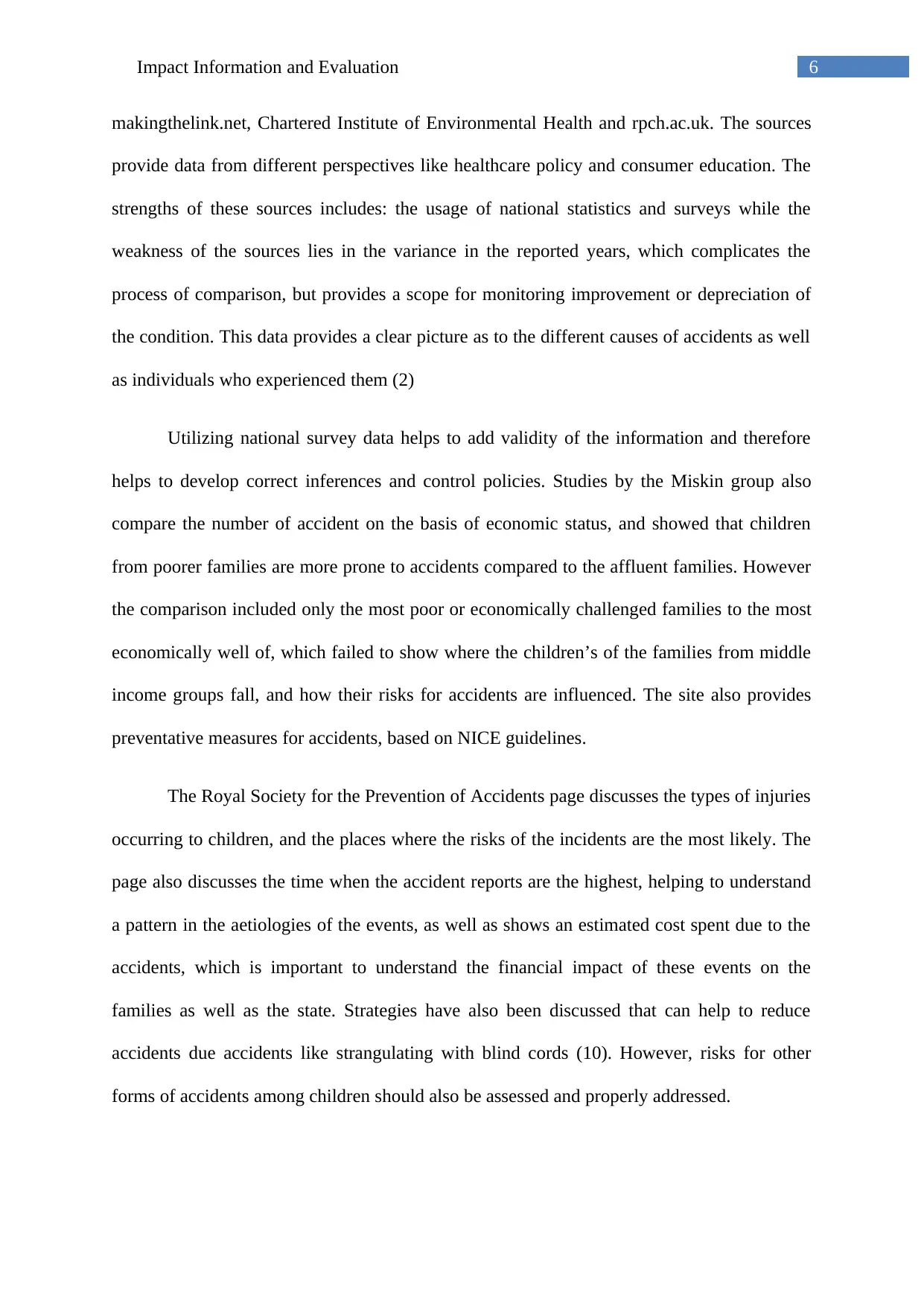
6Impact Information and Evaluation
makingthelink.net, Chartered Institute of Environmental Health and rpch.ac.uk. The sources
provide data from different perspectives like healthcare policy and consumer education. The
strengths of these sources includes: the usage of national statistics and surveys while the
weakness of the sources lies in the variance in the reported years, which complicates the
process of comparison, but provides a scope for monitoring improvement or depreciation of
the condition. This data provides a clear picture as to the different causes of accidents as well
as individuals who experienced them (2)
Utilizing national survey data helps to add validity of the information and therefore
helps to develop correct inferences and control policies. Studies by the Miskin group also
compare the number of accident on the basis of economic status, and showed that children
from poorer families are more prone to accidents compared to the affluent families. However
the comparison included only the most poor or economically challenged families to the most
economically well of, which failed to show where the children’s of the families from middle
income groups fall, and how their risks for accidents are influenced. The site also provides
preventative measures for accidents, based on NICE guidelines.
The Royal Society for the Prevention of Accidents page discusses the types of injuries
occurring to children, and the places where the risks of the incidents are the most likely. The
page also discusses the time when the accident reports are the highest, helping to understand
a pattern in the aetiologies of the events, as well as shows an estimated cost spent due to the
accidents, which is important to understand the financial impact of these events on the
families as well as the state. Strategies have also been discussed that can help to reduce
accidents due accidents like strangulating with blind cords (10). However, risks for other
forms of accidents among children should also be assessed and properly addressed.
makingthelink.net, Chartered Institute of Environmental Health and rpch.ac.uk. The sources
provide data from different perspectives like healthcare policy and consumer education. The
strengths of these sources includes: the usage of national statistics and surveys while the
weakness of the sources lies in the variance in the reported years, which complicates the
process of comparison, but provides a scope for monitoring improvement or depreciation of
the condition. This data provides a clear picture as to the different causes of accidents as well
as individuals who experienced them (2)
Utilizing national survey data helps to add validity of the information and therefore
helps to develop correct inferences and control policies. Studies by the Miskin group also
compare the number of accident on the basis of economic status, and showed that children
from poorer families are more prone to accidents compared to the affluent families. However
the comparison included only the most poor or economically challenged families to the most
economically well of, which failed to show where the children’s of the families from middle
income groups fall, and how their risks for accidents are influenced. The site also provides
preventative measures for accidents, based on NICE guidelines.
The Royal Society for the Prevention of Accidents page discusses the types of injuries
occurring to children, and the places where the risks of the incidents are the most likely. The
page also discusses the time when the accident reports are the highest, helping to understand
a pattern in the aetiologies of the events, as well as shows an estimated cost spent due to the
accidents, which is important to understand the financial impact of these events on the
families as well as the state. Strategies have also been discussed that can help to reduce
accidents due accidents like strangulating with blind cords (10). However, risks for other
forms of accidents among children should also be assessed and properly addressed.
Paraphrase This Document
Need a fresh take? Get an instant paraphrase of this document with our AI Paraphraser
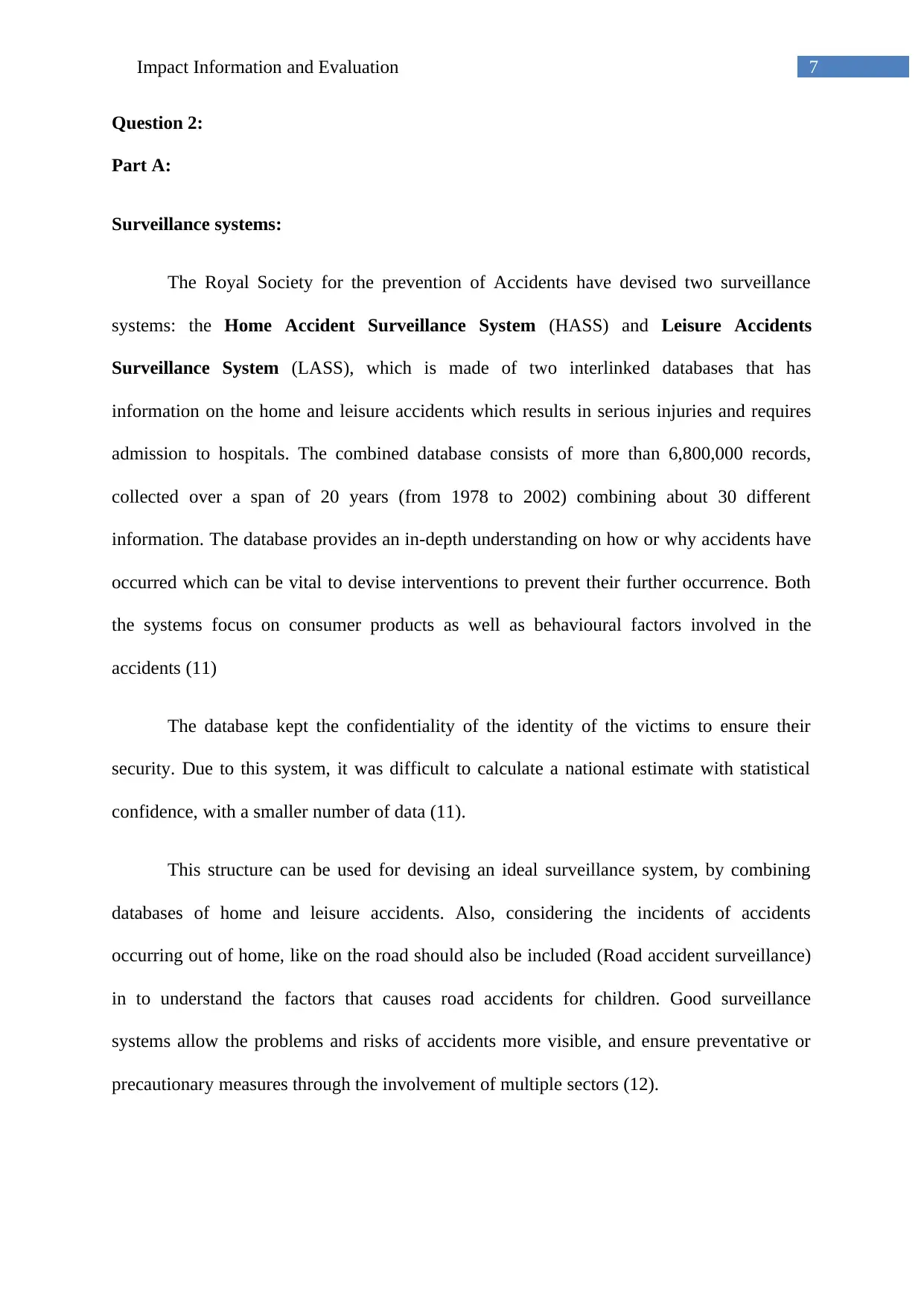
7Impact Information and Evaluation
Question 2:
Part A:
Surveillance systems:
The Royal Society for the prevention of Accidents have devised two surveillance
systems: the Home Accident Surveillance System (HASS) and Leisure Accidents
Surveillance System (LASS), which is made of two interlinked databases that has
information on the home and leisure accidents which results in serious injuries and requires
admission to hospitals. The combined database consists of more than 6,800,000 records,
collected over a span of 20 years (from 1978 to 2002) combining about 30 different
information. The database provides an in-depth understanding on how or why accidents have
occurred which can be vital to devise interventions to prevent their further occurrence. Both
the systems focus on consumer products as well as behavioural factors involved in the
accidents (11)
The database kept the confidentiality of the identity of the victims to ensure their
security. Due to this system, it was difficult to calculate a national estimate with statistical
confidence, with a smaller number of data (11).
This structure can be used for devising an ideal surveillance system, by combining
databases of home and leisure accidents. Also, considering the incidents of accidents
occurring out of home, like on the road should also be included (Road accident surveillance)
in to understand the factors that causes road accidents for children. Good surveillance
systems allow the problems and risks of accidents more visible, and ensure preventative or
precautionary measures through the involvement of multiple sectors (12).
Question 2:
Part A:
Surveillance systems:
The Royal Society for the prevention of Accidents have devised two surveillance
systems: the Home Accident Surveillance System (HASS) and Leisure Accidents
Surveillance System (LASS), which is made of two interlinked databases that has
information on the home and leisure accidents which results in serious injuries and requires
admission to hospitals. The combined database consists of more than 6,800,000 records,
collected over a span of 20 years (from 1978 to 2002) combining about 30 different
information. The database provides an in-depth understanding on how or why accidents have
occurred which can be vital to devise interventions to prevent their further occurrence. Both
the systems focus on consumer products as well as behavioural factors involved in the
accidents (11)
The database kept the confidentiality of the identity of the victims to ensure their
security. Due to this system, it was difficult to calculate a national estimate with statistical
confidence, with a smaller number of data (11).
This structure can be used for devising an ideal surveillance system, by combining
databases of home and leisure accidents. Also, considering the incidents of accidents
occurring out of home, like on the road should also be included (Road accident surveillance)
in to understand the factors that causes road accidents for children. Good surveillance
systems allow the problems and risks of accidents more visible, and ensure preventative or
precautionary measures through the involvement of multiple sectors (12).
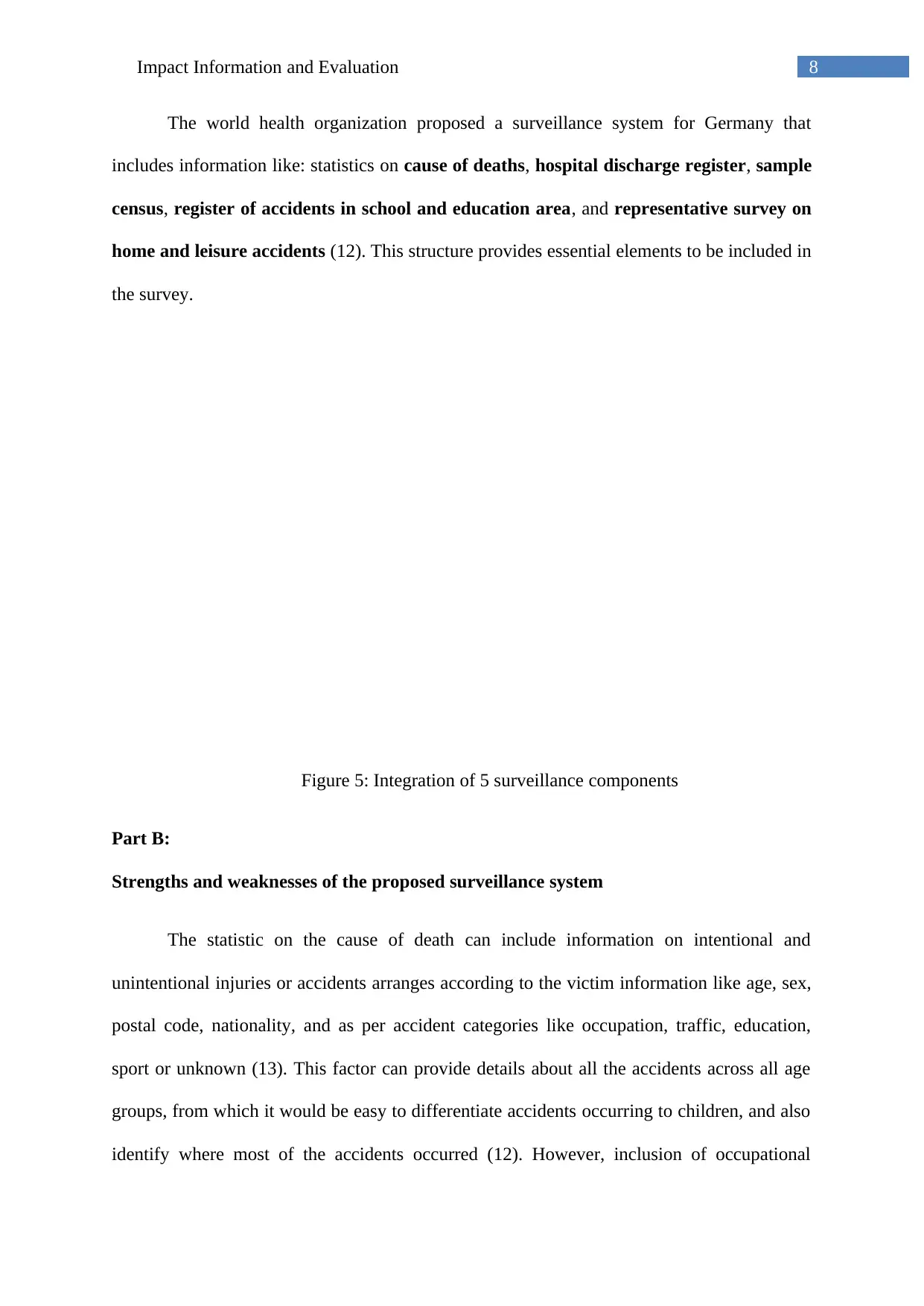
8Impact Information and Evaluation
The world health organization proposed a surveillance system for Germany that
includes information like: statistics on cause of deaths, hospital discharge register, sample
census, register of accidents in school and education area, and representative survey on
home and leisure accidents (12). This structure provides essential elements to be included in
the survey.
Figure 5: Integration of 5 surveillance components
Part B:
Strengths and weaknesses of the proposed surveillance system
The statistic on the cause of death can include information on intentional and
unintentional injuries or accidents arranges according to the victim information like age, sex,
postal code, nationality, and as per accident categories like occupation, traffic, education,
sport or unknown (13). This factor can provide details about all the accidents across all age
groups, from which it would be easy to differentiate accidents occurring to children, and also
identify where most of the accidents occurred (12). However, inclusion of occupational
SurveyllanceSystemcauseofdeathshospitaldischargeregistersamplecensusregisterofaccidentsinschoolandeducationarearepresentativesurveyonhomeandleisureaccidents
The world health organization proposed a surveillance system for Germany that
includes information like: statistics on cause of deaths, hospital discharge register, sample
census, register of accidents in school and education area, and representative survey on
home and leisure accidents (12). This structure provides essential elements to be included in
the survey.
Figure 5: Integration of 5 surveillance components
Part B:
Strengths and weaknesses of the proposed surveillance system
The statistic on the cause of death can include information on intentional and
unintentional injuries or accidents arranges according to the victim information like age, sex,
postal code, nationality, and as per accident categories like occupation, traffic, education,
sport or unknown (13). This factor can provide details about all the accidents across all age
groups, from which it would be easy to differentiate accidents occurring to children, and also
identify where most of the accidents occurred (12). However, inclusion of occupational
SurveyllanceSystemcauseofdeathshospitaldischargeregistersamplecensusregisterofaccidentsinschoolandeducationarearepresentativesurveyonhomeandleisureaccidents
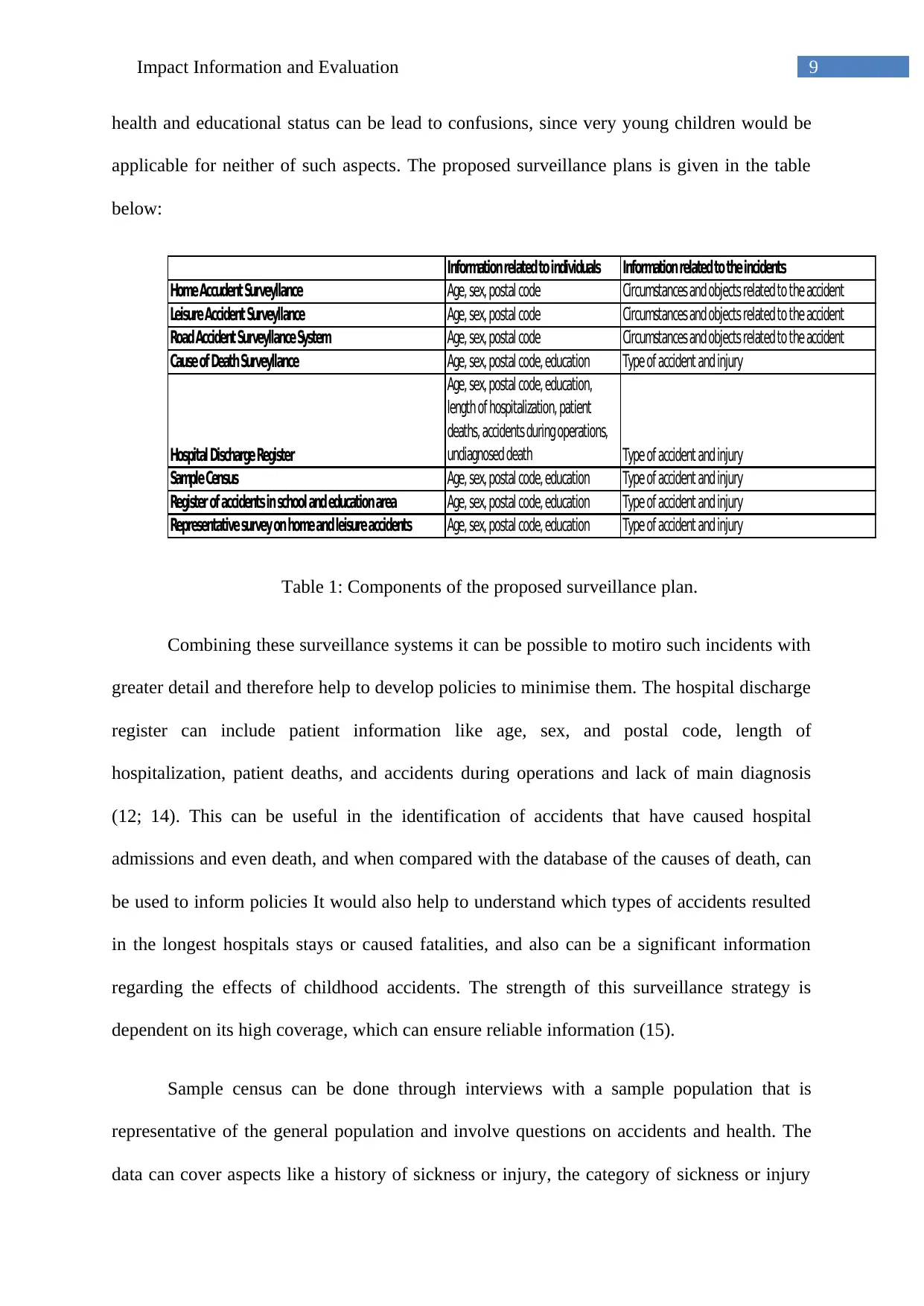
9Impact Information and Evaluation
health and educational status can be lead to confusions, since very young children would be
applicable for neither of such aspects. The proposed surveillance plans is given in the table
below:
Information related to individuals Information related to the incidents
Home Accudent Surveyllance Age, sex, postal code Circumstances and objects related to the accident
Leisure Accident Surveyllance Age, sex, postal code Circumstances and objects related to the accident
Road Accident Surveyllance System Age, sex, postal code Circumstances and objects related to the accident
Cause of Death Surveyllance Age, sex, postal code, education Type of accident and injury
Hospital Discharge Register
Age, sex, postal code, education,
length of hospitalization, patient
deaths, accidents during operations,
undiagnosed death Type of accident and injury
Sample Census Age, sex, postal code, education Type of accident and injury
Register of accidents in school and education area Age, sex, postal code, education Type of accident and injury
Representative survey on home and leisure accidents Age, sex, postal code, education Type of accident and injury
Table 1: Components of the proposed surveillance plan.
Combining these surveillance systems it can be possible to motiro such incidents with
greater detail and therefore help to develop policies to minimise them. The hospital discharge
register can include patient information like age, sex, and postal code, length of
hospitalization, patient deaths, and accidents during operations and lack of main diagnosis
(12; 14). This can be useful in the identification of accidents that have caused hospital
admissions and even death, and when compared with the database of the causes of death, can
be used to inform policies It would also help to understand which types of accidents resulted
in the longest hospitals stays or caused fatalities, and also can be a significant information
regarding the effects of childhood accidents. The strength of this surveillance strategy is
dependent on its high coverage, which can ensure reliable information (15).
Sample census can be done through interviews with a sample population that is
representative of the general population and involve questions on accidents and health. The
data can cover aspects like a history of sickness or injury, the category of sickness or injury
health and educational status can be lead to confusions, since very young children would be
applicable for neither of such aspects. The proposed surveillance plans is given in the table
below:
Information related to individuals Information related to the incidents
Home Accudent Surveyllance Age, sex, postal code Circumstances and objects related to the accident
Leisure Accident Surveyllance Age, sex, postal code Circumstances and objects related to the accident
Road Accident Surveyllance System Age, sex, postal code Circumstances and objects related to the accident
Cause of Death Surveyllance Age, sex, postal code, education Type of accident and injury
Hospital Discharge Register
Age, sex, postal code, education,
length of hospitalization, patient
deaths, accidents during operations,
undiagnosed death Type of accident and injury
Sample Census Age, sex, postal code, education Type of accident and injury
Register of accidents in school and education area Age, sex, postal code, education Type of accident and injury
Representative survey on home and leisure accidents Age, sex, postal code, education Type of accident and injury
Table 1: Components of the proposed surveillance plan.
Combining these surveillance systems it can be possible to motiro such incidents with
greater detail and therefore help to develop policies to minimise them. The hospital discharge
register can include patient information like age, sex, and postal code, length of
hospitalization, patient deaths, and accidents during operations and lack of main diagnosis
(12; 14). This can be useful in the identification of accidents that have caused hospital
admissions and even death, and when compared with the database of the causes of death, can
be used to inform policies It would also help to understand which types of accidents resulted
in the longest hospitals stays or caused fatalities, and also can be a significant information
regarding the effects of childhood accidents. The strength of this surveillance strategy is
dependent on its high coverage, which can ensure reliable information (15).
Sample census can be done through interviews with a sample population that is
representative of the general population and involve questions on accidents and health. The
data can cover aspects like a history of sickness or injury, the category of sickness or injury
Secure Best Marks with AI Grader
Need help grading? Try our AI Grader for instant feedback on your assignments.
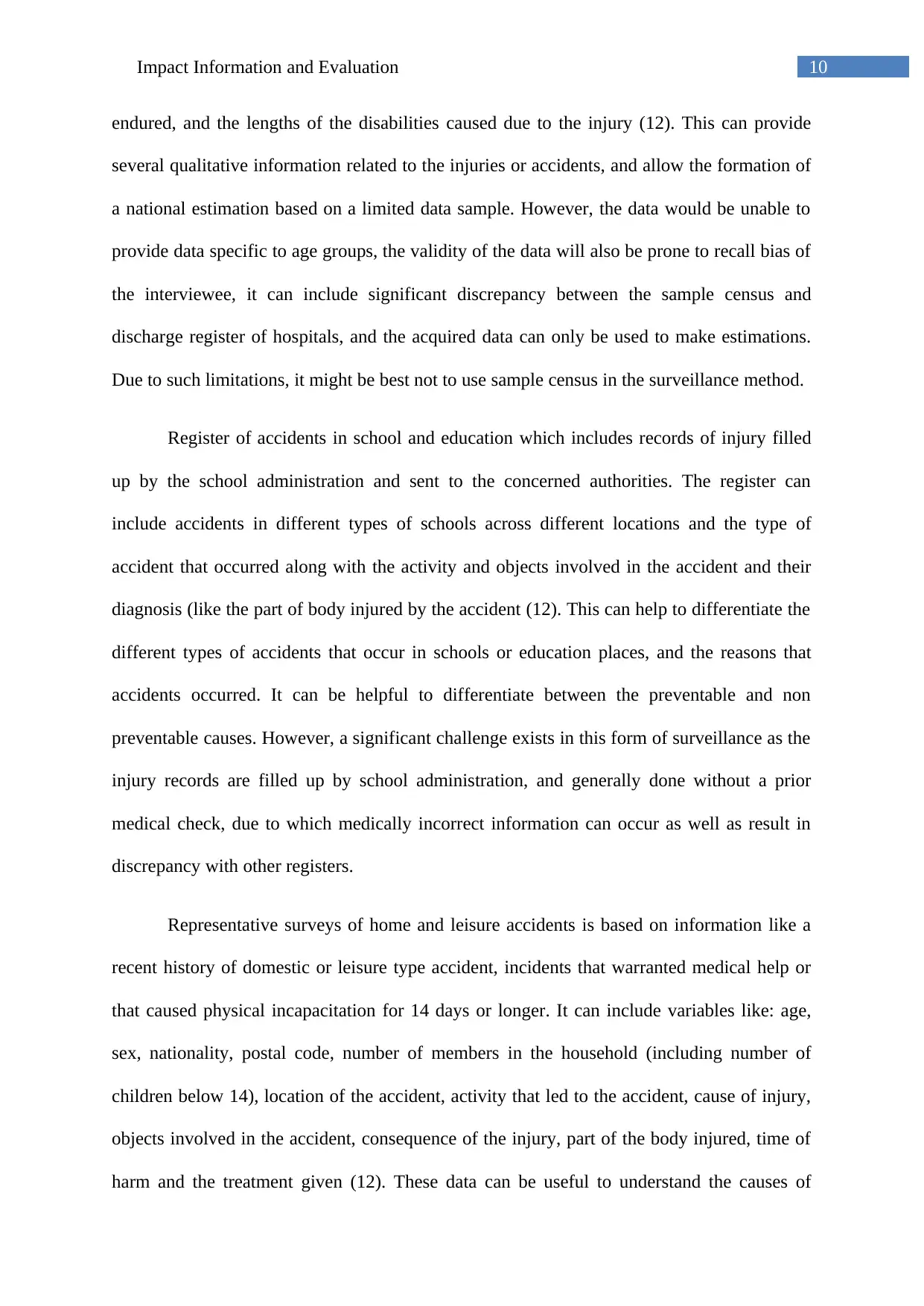
10Impact Information and Evaluation
endured, and the lengths of the disabilities caused due to the injury (12). This can provide
several qualitative information related to the injuries or accidents, and allow the formation of
a national estimation based on a limited data sample. However, the data would be unable to
provide data specific to age groups, the validity of the data will also be prone to recall bias of
the interviewee, it can include significant discrepancy between the sample census and
discharge register of hospitals, and the acquired data can only be used to make estimations.
Due to such limitations, it might be best not to use sample census in the surveillance method.
Register of accidents in school and education which includes records of injury filled
up by the school administration and sent to the concerned authorities. The register can
include accidents in different types of schools across different locations and the type of
accident that occurred along with the activity and objects involved in the accident and their
diagnosis (like the part of body injured by the accident (12). This can help to differentiate the
different types of accidents that occur in schools or education places, and the reasons that
accidents occurred. It can be helpful to differentiate between the preventable and non
preventable causes. However, a significant challenge exists in this form of surveillance as the
injury records are filled up by school administration, and generally done without a prior
medical check, due to which medically incorrect information can occur as well as result in
discrepancy with other registers.
Representative surveys of home and leisure accidents is based on information like a
recent history of domestic or leisure type accident, incidents that warranted medical help or
that caused physical incapacitation for 14 days or longer. It can include variables like: age,
sex, nationality, postal code, number of members in the household (including number of
children below 14), location of the accident, activity that led to the accident, cause of injury,
objects involved in the accident, consequence of the injury, part of the body injured, time of
harm and the treatment given (12). These data can be useful to understand the causes of
endured, and the lengths of the disabilities caused due to the injury (12). This can provide
several qualitative information related to the injuries or accidents, and allow the formation of
a national estimation based on a limited data sample. However, the data would be unable to
provide data specific to age groups, the validity of the data will also be prone to recall bias of
the interviewee, it can include significant discrepancy between the sample census and
discharge register of hospitals, and the acquired data can only be used to make estimations.
Due to such limitations, it might be best not to use sample census in the surveillance method.
Register of accidents in school and education which includes records of injury filled
up by the school administration and sent to the concerned authorities. The register can
include accidents in different types of schools across different locations and the type of
accident that occurred along with the activity and objects involved in the accident and their
diagnosis (like the part of body injured by the accident (12). This can help to differentiate the
different types of accidents that occur in schools or education places, and the reasons that
accidents occurred. It can be helpful to differentiate between the preventable and non
preventable causes. However, a significant challenge exists in this form of surveillance as the
injury records are filled up by school administration, and generally done without a prior
medical check, due to which medically incorrect information can occur as well as result in
discrepancy with other registers.
Representative surveys of home and leisure accidents is based on information like a
recent history of domestic or leisure type accident, incidents that warranted medical help or
that caused physical incapacitation for 14 days or longer. It can include variables like: age,
sex, nationality, postal code, number of members in the household (including number of
children below 14), location of the accident, activity that led to the accident, cause of injury,
objects involved in the accident, consequence of the injury, part of the body injured, time of
harm and the treatment given (12). These data can be useful to understand the causes of

11Impact Information and Evaluation
accidents in home or doing leisure activities. Also, these information can help to understand
which age groups are most prone to accidents at home, and the most common types of
injuries suffered by the accidents. Proper reporting in the surveys can also ensure high
reliability of the data.
Conclusion:
Accidents are a common source of injury and harm to the well being of children, and
also are related to several cases of fatality every year. Children often experience various types
of accidents at home or on the roads, and the type and causes of the accidents vary according
to their ages and gender. Surveillance systems that collect data of accidents from hospitals,
schools and clinics as well as from self surveys and questionnaires can be effective to
monitor these incidents and prevent its recurrence.
accidents in home or doing leisure activities. Also, these information can help to understand
which age groups are most prone to accidents at home, and the most common types of
injuries suffered by the accidents. Proper reporting in the surveys can also ensure high
reliability of the data.
Conclusion:
Accidents are a common source of injury and harm to the well being of children, and
also are related to several cases of fatality every year. Children often experience various types
of accidents at home or on the roads, and the type and causes of the accidents vary according
to their ages and gender. Surveillance systems that collect data of accidents from hospitals,
schools and clinics as well as from self surveys and questionnaires can be effective to
monitor these incidents and prevent its recurrence.
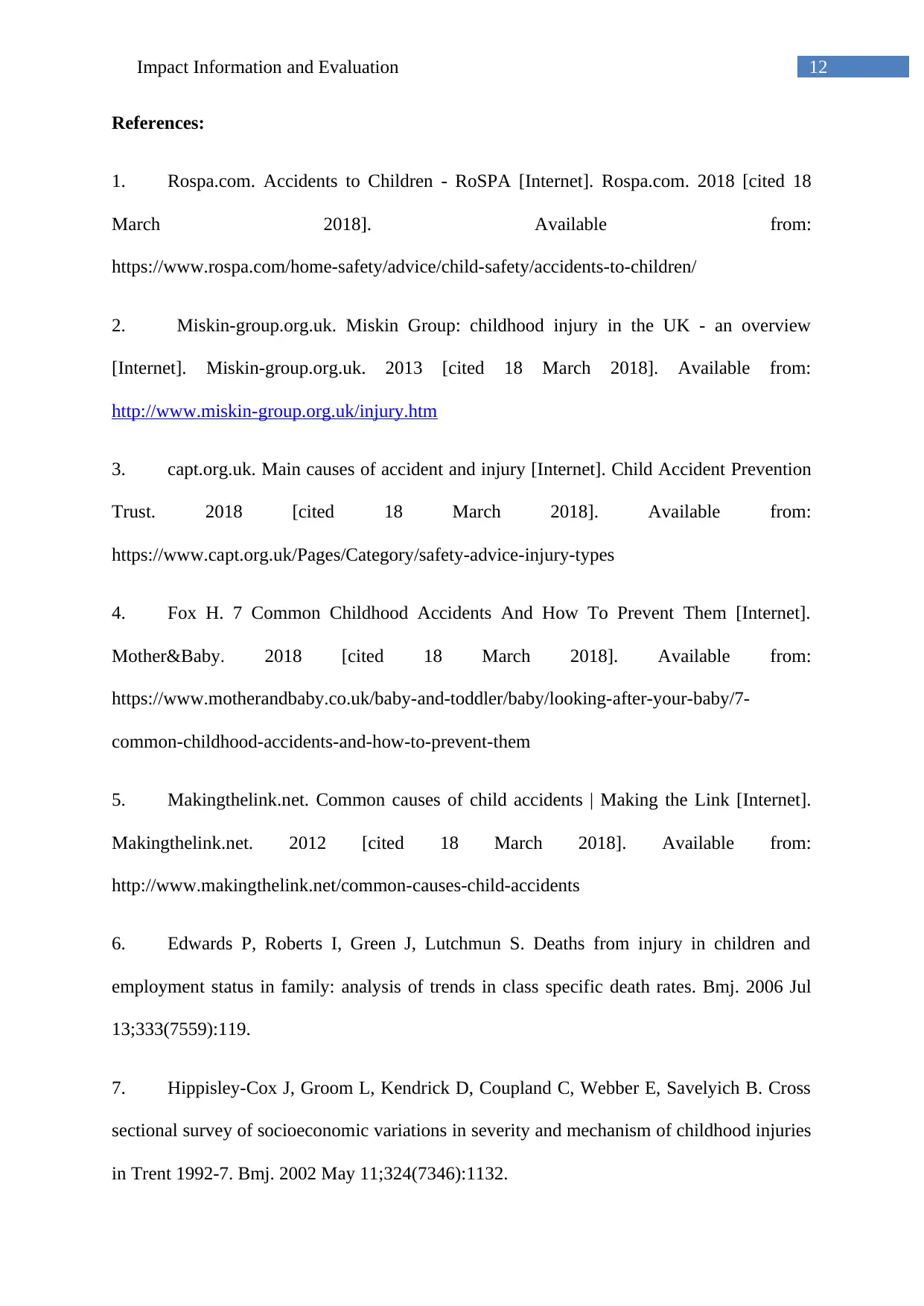
12Impact Information and Evaluation
References:
1. Rospa.com. Accidents to Children - RoSPA [Internet]. Rospa.com. 2018 [cited 18
March 2018]. Available from:
https://www.rospa.com/home-safety/advice/child-safety/accidents-to-children/
2. Miskin-group.org.uk. Miskin Group: childhood injury in the UK - an overview
[Internet]. Miskin-group.org.uk. 2013 [cited 18 March 2018]. Available from:
http://www.miskin-group.org.uk/injury.htm
3. capt.org.uk. Main causes of accident and injury [Internet]. Child Accident Prevention
Trust. 2018 [cited 18 March 2018]. Available from:
https://www.capt.org.uk/Pages/Category/safety-advice-injury-types
4. Fox H. 7 Common Childhood Accidents And How To Prevent Them [Internet].
Mother&Baby. 2018 [cited 18 March 2018]. Available from:
https://www.motherandbaby.co.uk/baby-and-toddler/baby/looking-after-your-baby/7-
common-childhood-accidents-and-how-to-prevent-them
5. Makingthelink.net. Common causes of child accidents | Making the Link [Internet].
Makingthelink.net. 2012 [cited 18 March 2018]. Available from:
http://www.makingthelink.net/common-causes-child-accidents
6. Edwards P, Roberts I, Green J, Lutchmun S. Deaths from injury in children and
employment status in family: analysis of trends in class specific death rates. Bmj. 2006 Jul
13;333(7559):119.
7. Hippisley-Cox J, Groom L, Kendrick D, Coupland C, Webber E, Savelyich B. Cross
sectional survey of socioeconomic variations in severity and mechanism of childhood injuries
in Trent 1992-7. Bmj. 2002 May 11;324(7346):1132.
References:
1. Rospa.com. Accidents to Children - RoSPA [Internet]. Rospa.com. 2018 [cited 18
March 2018]. Available from:
https://www.rospa.com/home-safety/advice/child-safety/accidents-to-children/
2. Miskin-group.org.uk. Miskin Group: childhood injury in the UK - an overview
[Internet]. Miskin-group.org.uk. 2013 [cited 18 March 2018]. Available from:
http://www.miskin-group.org.uk/injury.htm
3. capt.org.uk. Main causes of accident and injury [Internet]. Child Accident Prevention
Trust. 2018 [cited 18 March 2018]. Available from:
https://www.capt.org.uk/Pages/Category/safety-advice-injury-types
4. Fox H. 7 Common Childhood Accidents And How To Prevent Them [Internet].
Mother&Baby. 2018 [cited 18 March 2018]. Available from:
https://www.motherandbaby.co.uk/baby-and-toddler/baby/looking-after-your-baby/7-
common-childhood-accidents-and-how-to-prevent-them
5. Makingthelink.net. Common causes of child accidents | Making the Link [Internet].
Makingthelink.net. 2012 [cited 18 March 2018]. Available from:
http://www.makingthelink.net/common-causes-child-accidents
6. Edwards P, Roberts I, Green J, Lutchmun S. Deaths from injury in children and
employment status in family: analysis of trends in class specific death rates. Bmj. 2006 Jul
13;333(7559):119.
7. Hippisley-Cox J, Groom L, Kendrick D, Coupland C, Webber E, Savelyich B. Cross
sectional survey of socioeconomic variations in severity and mechanism of childhood injuries
in Trent 1992-7. Bmj. 2002 May 11;324(7346):1132.
Paraphrase This Document
Need a fresh take? Get an instant paraphrase of this document with our AI Paraphraser
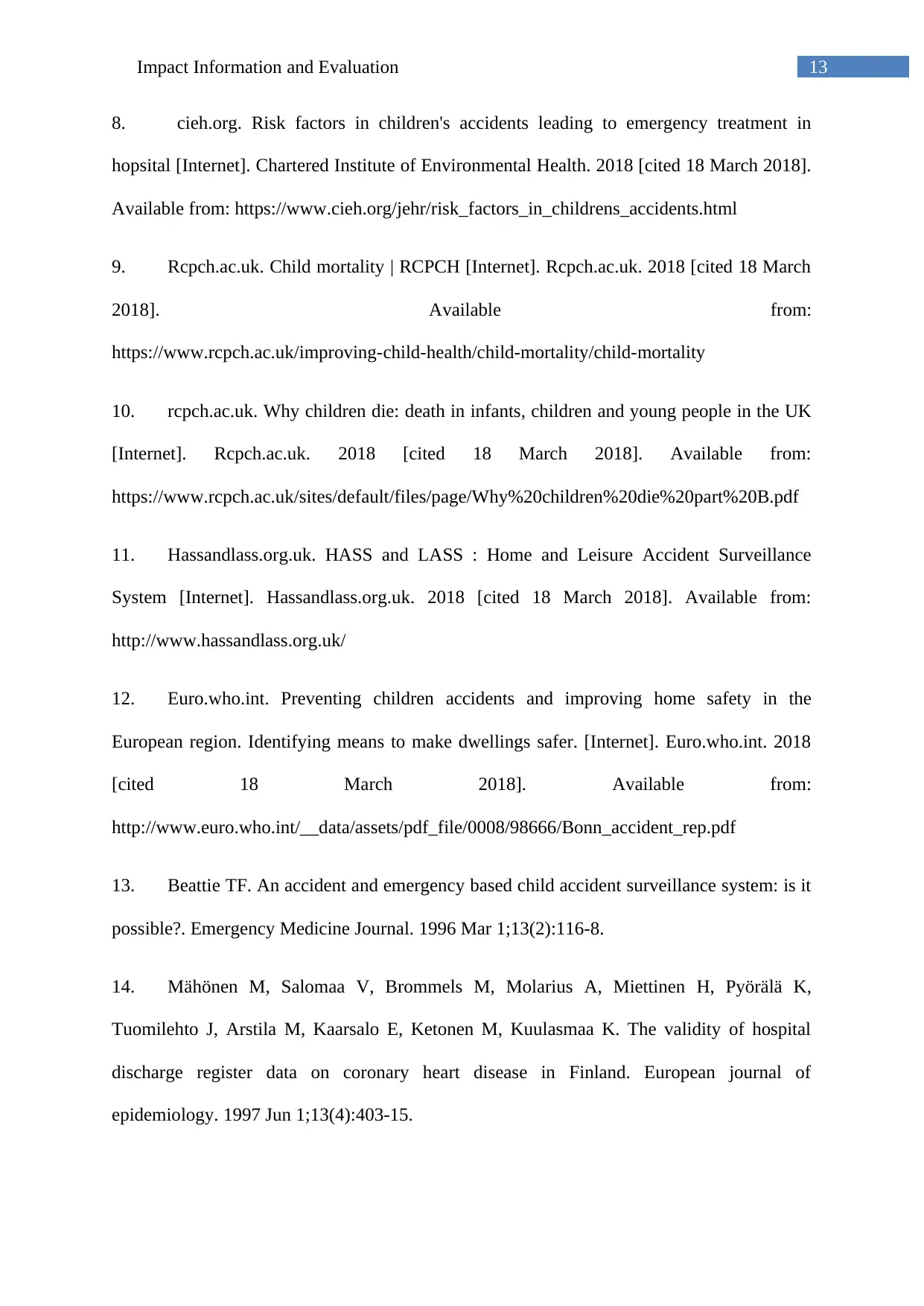
13Impact Information and Evaluation
8. cieh.org. Risk factors in children's accidents leading to emergency treatment in
hopsital [Internet]. Chartered Institute of Environmental Health. 2018 [cited 18 March 2018].
Available from: https://www.cieh.org/jehr/risk_factors_in_childrens_accidents.html
9. Rcpch.ac.uk. Child mortality | RCPCH [Internet]. Rcpch.ac.uk. 2018 [cited 18 March
2018]. Available from:
https://www.rcpch.ac.uk/improving-child-health/child-mortality/child-mortality
10. rcpch.ac.uk. Why children die: death in infants, children and young people in the UK
[Internet]. Rcpch.ac.uk. 2018 [cited 18 March 2018]. Available from:
https://www.rcpch.ac.uk/sites/default/files/page/Why%20children%20die%20part%20B.pdf
11. Hassandlass.org.uk. HASS and LASS : Home and Leisure Accident Surveillance
System [Internet]. Hassandlass.org.uk. 2018 [cited 18 March 2018]. Available from:
http://www.hassandlass.org.uk/
12. Euro.who.int. Preventing children accidents and improving home safety in the
European region. Identifying means to make dwellings safer. [Internet]. Euro.who.int. 2018
[cited 18 March 2018]. Available from:
http://www.euro.who.int/__data/assets/pdf_file/0008/98666/Bonn_accident_rep.pdf
13. Beattie TF. An accident and emergency based child accident surveillance system: is it
possible?. Emergency Medicine Journal. 1996 Mar 1;13(2):116-8.
14. Mähönen M, Salomaa V, Brommels M, Molarius A, Miettinen H, Pyörälä K,
Tuomilehto J, Arstila M, Kaarsalo E, Ketonen M, Kuulasmaa K. The validity of hospital
discharge register data on coronary heart disease in Finland. European journal of
epidemiology. 1997 Jun 1;13(4):403-15.
8. cieh.org. Risk factors in children's accidents leading to emergency treatment in
hopsital [Internet]. Chartered Institute of Environmental Health. 2018 [cited 18 March 2018].
Available from: https://www.cieh.org/jehr/risk_factors_in_childrens_accidents.html
9. Rcpch.ac.uk. Child mortality | RCPCH [Internet]. Rcpch.ac.uk. 2018 [cited 18 March
2018]. Available from:
https://www.rcpch.ac.uk/improving-child-health/child-mortality/child-mortality
10. rcpch.ac.uk. Why children die: death in infants, children and young people in the UK
[Internet]. Rcpch.ac.uk. 2018 [cited 18 March 2018]. Available from:
https://www.rcpch.ac.uk/sites/default/files/page/Why%20children%20die%20part%20B.pdf
11. Hassandlass.org.uk. HASS and LASS : Home and Leisure Accident Surveillance
System [Internet]. Hassandlass.org.uk. 2018 [cited 18 March 2018]. Available from:
http://www.hassandlass.org.uk/
12. Euro.who.int. Preventing children accidents and improving home safety in the
European region. Identifying means to make dwellings safer. [Internet]. Euro.who.int. 2018
[cited 18 March 2018]. Available from:
http://www.euro.who.int/__data/assets/pdf_file/0008/98666/Bonn_accident_rep.pdf
13. Beattie TF. An accident and emergency based child accident surveillance system: is it
possible?. Emergency Medicine Journal. 1996 Mar 1;13(2):116-8.
14. Mähönen M, Salomaa V, Brommels M, Molarius A, Miettinen H, Pyörälä K,
Tuomilehto J, Arstila M, Kaarsalo E, Ketonen M, Kuulasmaa K. The validity of hospital
discharge register data on coronary heart disease in Finland. European journal of
epidemiology. 1997 Jun 1;13(4):403-15.
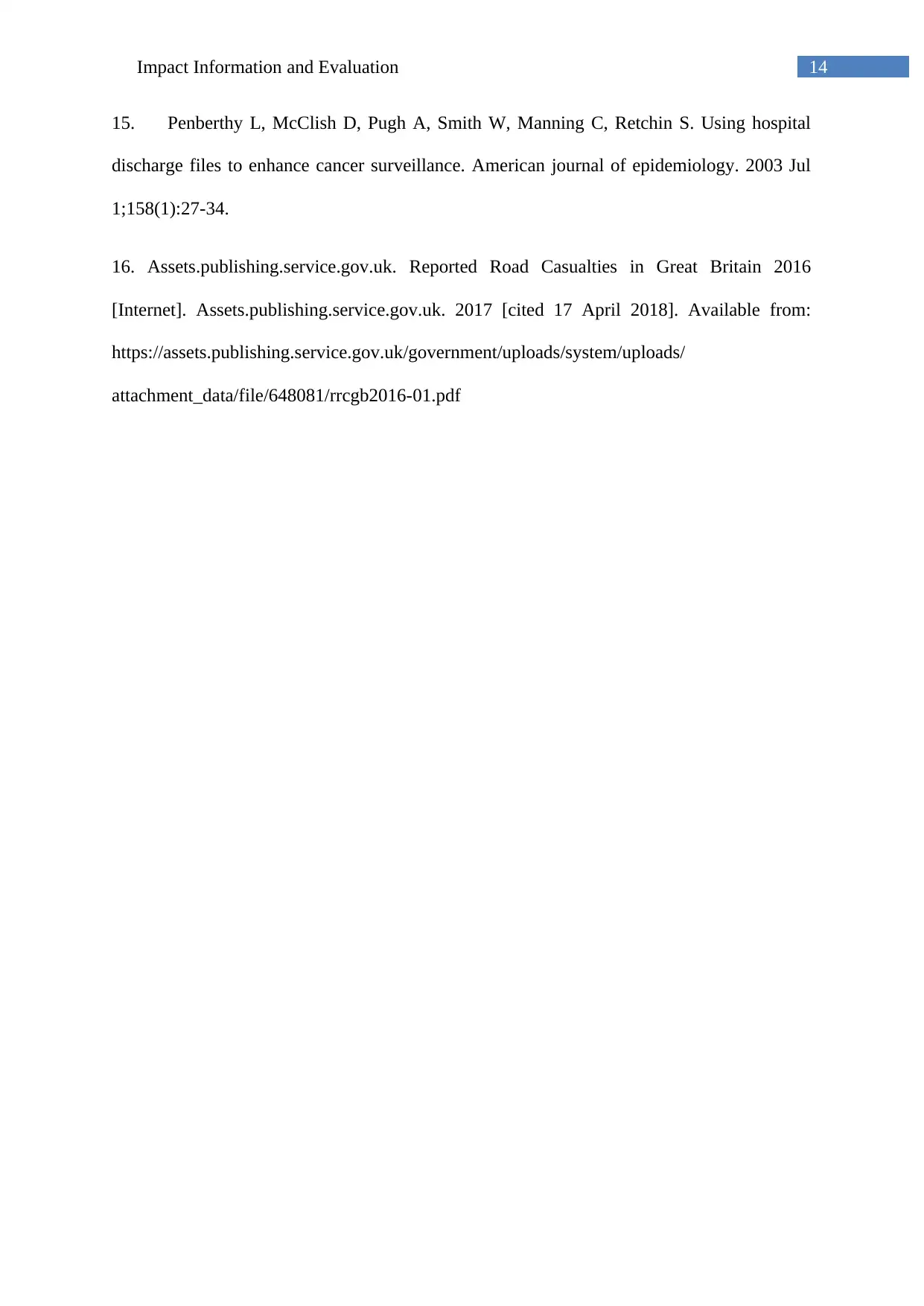
14Impact Information and Evaluation
15. Penberthy L, McClish D, Pugh A, Smith W, Manning C, Retchin S. Using hospital
discharge files to enhance cancer surveillance. American journal of epidemiology. 2003 Jul
1;158(1):27-34.
16. Assets.publishing.service.gov.uk. Reported Road Casualties in Great Britain 2016
[Internet]. Assets.publishing.service.gov.uk. 2017 [cited 17 April 2018]. Available from:
https://assets.publishing.service.gov.uk/government/uploads/system/uploads/
attachment_data/file/648081/rrcgb2016-01.pdf
15. Penberthy L, McClish D, Pugh A, Smith W, Manning C, Retchin S. Using hospital
discharge files to enhance cancer surveillance. American journal of epidemiology. 2003 Jul
1;158(1):27-34.
16. Assets.publishing.service.gov.uk. Reported Road Casualties in Great Britain 2016
[Internet]. Assets.publishing.service.gov.uk. 2017 [cited 17 April 2018]. Available from:
https://assets.publishing.service.gov.uk/government/uploads/system/uploads/
attachment_data/file/648081/rrcgb2016-01.pdf
1 out of 15
Your All-in-One AI-Powered Toolkit for Academic Success.
+13062052269
info@desklib.com
Available 24*7 on WhatsApp / Email
![[object Object]](/_next/static/media/star-bottom.7253800d.svg)
Unlock your academic potential
© 2024 | Zucol Services PVT LTD | All rights reserved.





